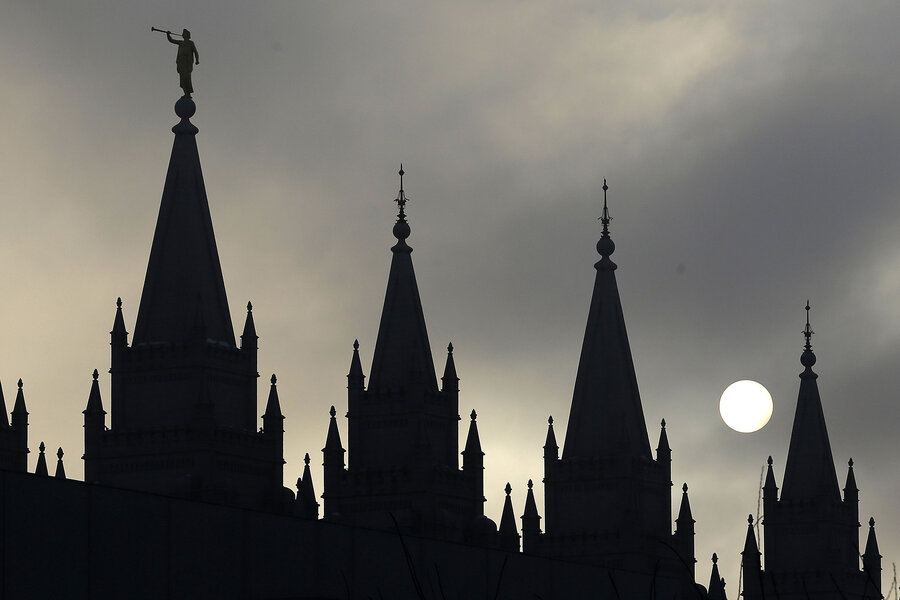Mormon 'mass resignation' over LGBT rules: Big deal for the church?
Loading...
A protest featuring a "mass resignation" of Mormons from their church Saturday over a recently announced policy on LGBT families is not a new form of opposition for the 185-year-old church.
Several hundred people attended the rally in Salt Lake City, reports the Associated Press (more than 1,000 reported the Salt Lake Tribune), to renounce the church's new policies targeting homosexuals and their children. Many of those attending dropped off letters of resignation at a nearby church building. Most had stopped attending church years ago, but they wanted to formally cut ties with the religion.
The Church of Jesus Christ of Latter-day Saints responded to the outcry over the policies with a 10-minute video interview Friday by a top-tier church leader and an official letter signed by the church's three highest authorities, reported Reuters. The response seems designed to temper members' concerns by contextualizing Saturday's protest within Mormon history:
During the church's early years, resignations occurred even within the inner circle of leaders under founder Joseph Smith, though many were later welcomed back to the church. Of that time, according to the church's website LDS.org, Joseph Smith wrote in 1837:
It seemed as though all the powers of earth and hell were combining their influence in an especial manner to overthrow the Church at once. … The enemy abroad, and apostates in our midst, united in their schemes, … and many became disaffected toward me as though I were the sole cause of those very evils I was most strenuously striving against.
When Mormon leaders publicly opposed the controversial Equal Rights Amendment in the 1970s, dissident members openly protested against the church. A group of pro-ERA Mormon women – including later-excommunicated leader Sonia Johnson – chained themselves to the gates of a Mormon temple in Washington, and other activists caused a stir in Ogden, Utah, where they publicly burned Mormon temple garments in protest, Charles McCollum wrote for the Cache Valley Herald Journal.
The latest controversy began after the church's Nov. 5 announcement of the policy regarding children of LGBT parents. The rules ban baptisms for children living with gay parents until they turn 18, disavow same-sex relationships and get approval from global church leaders. They also make gay marriages a sin worthy of expulsion.
"Any policy that affects children is going to evoke a lot of emotion," Brooke Swallow, one of the protest organizers, told the Associated Press.
After the rules announcement, separate petitions began circulating urging performers set to sing with the Mormon Tabernacle Choir to reconsider and urged NCAA sports teams to boycott games against Brigham Young University, Erin Alberty reported for the Salt Lake Tribune.
Such boycotts have a precedent. In the 1960s and '70s, sports events with the church-owned Brigham Young University saw protests over the church's ban on priesthood ordination to blacks, later abolished in 1978. During a 1970 basketball game against Colorado State, protesters threw raw eggs and a flaming molotov cocktail onto the court, Jay Drew wrote for the Salt Lake Tribune.
In 2012, a mass resignation protest of 120 included a hike to Salt Lake City's Ensign Peak, the Salt Lake Tribune reported. The group sent letters stating their intent to local leaders and then hiked to the peak's top with signs reading, "Finally ExMormon," "Research the church," and "Transcend Mormonism."
Church leaders say that the most recent defections follow society's trend toward secularization, Mormon Elder Marlin Jensen said in a university class, Peter Henderson and Kristina Cooke reported for Reuters.
"We are aware, and I'm speaking of the 15 men that are above me in the hierarchy of the church," Mr. Jensen, according to a 2012 tape recording of his unscripted remarks obtained by Reuters. "I think we are at a time of challenge, but it isn't apocalyptic."
As Jensen cited history of other times "of challenge," he told the Mormon students that their leaders care about the most recent concerns from inside and outside the church's membership, but they continue to work and solve them as they have done before.








